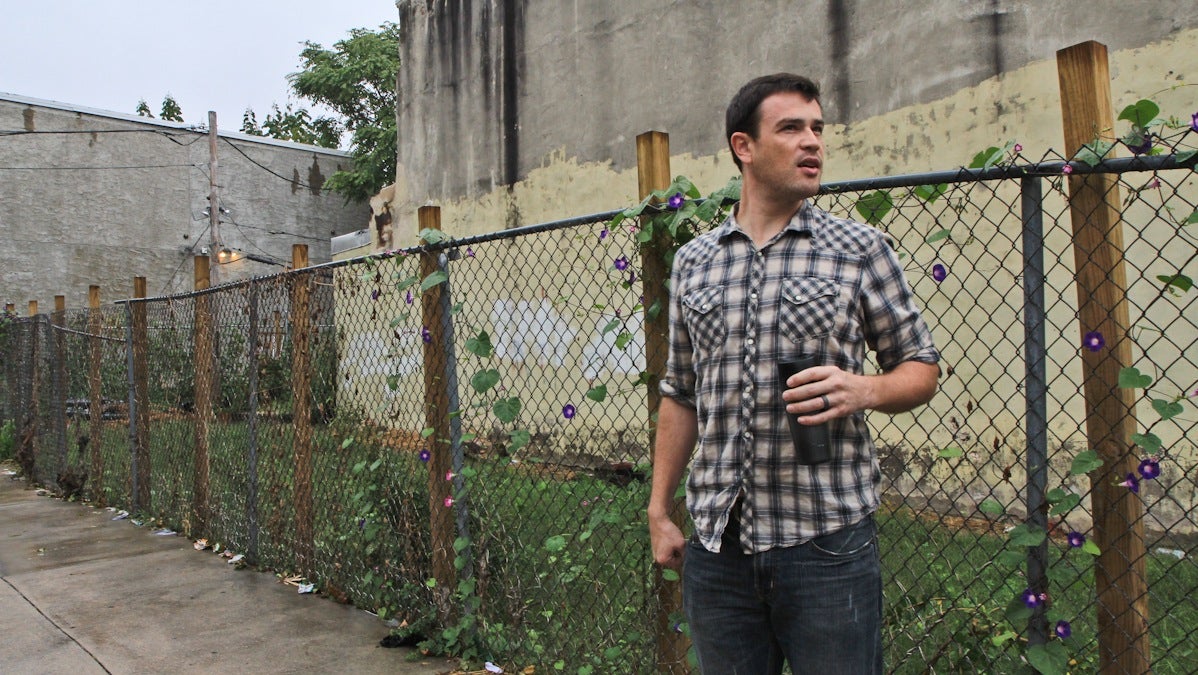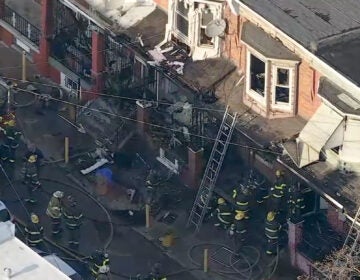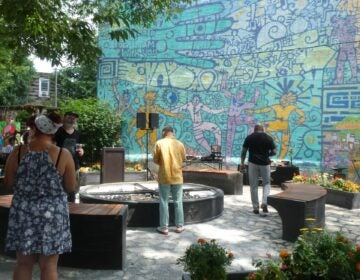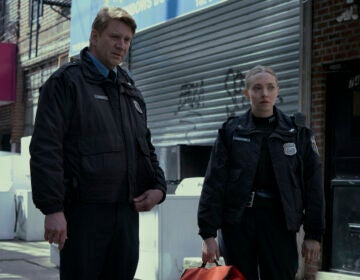Q&A with Kensington community activist Jamie Moffett
At age 21, Jamie Moffett made a down payment with some friends on a house in Kensington and moved in the next day. He has been involved in rebuilding the community ever since.
Listen
Jamie Moffett, a filmmaker and community activist in Kensington, says he is optimistic that the city can foster equitable neighborhood development for all Philadelphia neighborhoods. (Kimberly Paynter/WHYY, file)
Speak Easy is examining issues of neighborhood development in Philadelphia. How can city leaders help us achieve a fair future for long-term residents and newcomers alike? Seeking diverse perspectives on these issues, NewsWorks is hosting a public forum, “Philadelphia Neighborhoods in Flux,” on April 21 at WHYY studios. Registration is free at whyy.org/speakeasy.
—
Jamie Moffett’s family has a 150-year history in this area. “Whatever boat we got off of, it was on the Delaware River, and we kind of stayed there,” he says.
The documentary filmmaker and community activist grew up in Palmyra, N.J., and moved across the river to go to college at Eastern University right outside of Villanova. Moffett was drawn to community work in the mid-’90s, when he and some college friends befriended the homeless families camped out at the abandoned St. Edward’s Church at 8th and York streets.
“The Catholic Church wanted them removed, the families arrested, the kids taken away,” he said.
So he and his friends went house shopping after they graduated. Eighteen years ago, they made a down payment on a house in Kensington with his credit card and moved in the next day. He has been involved in rebuilding that community ever since.
Why Kensington?
It’s where a lot of families that were homeless were from. We spent so much time commuting to that neighborhood, we figured we should live where we worked. It was about homeless advocacy, living in the community you admire and want to be a part of.
The experience that I had of meeting folks different from me is something I’ll never lose. And now I don’t feel like these folks are different from me anymore. I hear about Kensington as “other.” And that just that doesn’t resonate with me anymore.
Years later, how did you get involved with Kensington Renewal?
I bought an old barber shop across the street for my production studio. And I noticed an uptick in drug activity right on the corner.
My buddy Shane and I went to Iraq in January 2010 during the war [for a documentary film project]. I was statistically safer in Iraq during the war than on my own block in Kensignton. Someone is going to die by a handgun because of drugs in the next x number of days. And it was happening in front of vacant spaces, abandoned lots, places covered with trash. When you called the cops, drug dealers would throw their stash into the garbage piles, and the cops would never notice.
So I put on my documentary filmmaker hat. I thought, ‘What kind of movie do you want to live in? A post-apocalyptic nightmare with drug-addled zombies? Or a nice street with flowers and trees and kids playing outside?’ I started going to community organizations in other neighborhoods to see what other people were doing.
I started cleaning up the street. I went to Greensgrow Farms and planted trees and flowers. They’re still there. The neighbors take care of them. So there were these visual cues: This block doesn’t support that kind of negative activity anymore.
I started getting a lot of momentum, and out of that, people suggested to me that I start an initiative, a nonprofit, so that we could acquire resources for street sweeping and to acquire abandoned properties — we call them ‘abandominiums.’
The neighbors started coming outside again. It didn’t look like a place where you would want to sell drugs. We created a culture where that kind activity wasn’t welcome anymore. So I put on my movie hat on in Kensington and came up with an analogy that worked for me and might make sense to other folks.
Your focus so far has been on creating home ownership opportunities for low-income residents. What about renters?
In New York there are rent control functions built into the system. There doesn’t seem to be that in Philly. Perhaps if there was a regulation like that here, developers would go nuts. There would be a pretty serious backlash. I guess at this point in time my hope is more toward home ownership because of the statistical relationship between home ownership and crime. As the rate of home ownership goes up, the crime rate goes down.
I don’t see a way to lock in long-term residents to a place where they want to be apart from home ownership at this time.
I don’t think everyone should be a homeowner. Not everyone has the desire even to be a homeowner. But we need to make sure housing is affordable for everyone.
You’ve said you hate the word “gentrification.” What is a better word? How should we frame the discussion?
If you look at the dictionary definitions of the word, some are inherently neutral. It’s how it’s applied that can be really negative. The idea of development could be good; it could be bad. I guess it depends on what part of the equation you’re invovled in.
New Kensington CDC did a great job with Fishtown. They have a credit repair and home ownership program. It’s a 12-month class to get your credit back into repair. And if you complete it, they escort you into a mortgage product to help acquire a home in Kensington.It takes a lot of work, weekly or biweekly. It takes a lof of shifting what you spend your money on, working your behind off just to get a job. It’s a culture shift for someone who has been out of the workforce for a while.
What has been happening in Philly in the last century? Where did the wave of neighborhood development start, how is it spreading, and what does it mean for the future of the city?
It’s clear that development is moving north from the Society Hill Towers into Kensington, Fishtown, Port Richmond. I’m concerned that these neighborhoods will be torn apart because of the money coming in and displacing people who have lived there.
There are a lot of examples of neighborhoods where there’s this tension between pre-existing residents and developers and new residents. It doesn’t have to happen that way. We just need additional planning so there is a chance of long-term residents being able to partake in the benefits, in the positive changes happening.
We’re following the trajectories of major European cities. In Paris there are no poor people. The poor people are pushed out to the suburbs. The same pattern is happening here.
What was going on before that initial wave hit?
In the ’40s and ’50s, it was after the war. It was a boom time. On American Street, it was just a line of factories from Lehigh to Girard. The story was, if you wanted a job, all you had to do was walk from Lehigh to Girard on American Street and stop at every factory, and you could have a job by the end of the day.
The decline occurred in the late ’60s and early ’70s. Factories closed, jobs moved to the burbs and New Jersey. Development, “gentrification,” as we understand it — the vacancy wasn’t there to be filled until that time.
WHYY is your source for fact-based, in-depth journalism and information. As a nonprofit organization, we rely on financial support from readers like you. Please give today.





